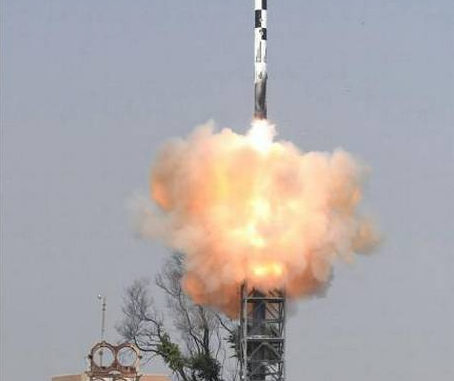
Capable of meeting challenges faced by national security

“China now possesses 350 nuclear warheads, while Pakistan has 165, and India 156, according to the latest assessment of the Stockholm International Peace Institute (SIPRI). Apart from its land-based nuclear missiles, India launched its third nuclear submarine barely a month ago. It is said to have a capability to launch eight ballistic missiles. The two earlier submarines can reportedly launch four missiles each. India now has the capability of ‘canisterising’, or storing the missiles in a sealed, climate controlled tube to protect them during transportation. This would apply to the entire range of missiles, including the recently tested Agni-P and the Agni-V, which has a range of 5,500 km. Many studies allude to an important role of the French-built Mirage 2000 and Rafale, as carriers of India’s nuclear weapons.”
An important feature of India’s nuclear deterrent has been the calibrated secrecy surrounding its growth. This is essential, as India’s nuclear weapons and missile programs have a large involvement of dedicated scientists and engineers from the DRDO, the Department of Atomic Energy, academic institutions, and commercial organizations from the public and private sectors. India’s nuclear weapons programme is under continuing worldwide scrutiny, including by specialist organizations like the Federation of American Scientists and similar organizations in the UK, France, Russia, and doubtless, China and Pakistan.
India has produced three nuclear-powered submarines, and could induct the fourth next year.
While Indian scientists have made discreet statements about our ballistic missile tests, one finds more details of our nuclear weapons and ballistic missiles in studies by American scientific publications like the Bulletin of Atomic Scientists and other organizations like the MacArthur Foundation. Such studies are carefully researched and counterchecked. These are not significantly different from what one periodically finds in writings in India.
According to the Bulletin of Atomic Scientists, India has enough weapons grade plutonium to produce 150 to 200 nuclear weapons, with a current estimated stockpile of 150 nuclear weapons. There is potential to step up production of fissile material significantly through the growing numbers of fast breeder and other plutonium reactors. According to the infamous Dr AQ Khan, Pakistan provided China with the centrifuge technology for enriched uranium, whose details he had purloined in Europe in the 1970s and 1980s. China, in turn, provided Pakistan the knowhow to utilize enriched uranium produced in Pakistan for nuclear weapons. The then US President Jimmy Carter looked the other way at these developments after he was swept off his feet by his ‘friendship’ with Chinese leader Deng Xiaoping.
China now possesses 350 nuclear warheads, while Pakistan has 165, and India 156, according to the latest assessment of the Stockholm International Peace Institute (SIPRI). Apart from its land-based nuclear missiles, India launched its third nuclear submarine barely a month ago. It is said to have a capability to launch eight ballistic missiles. The two earlier submarines can reportedly launch four missiles each. India now has the capability of ‘canister sing’, or storing the missiles in a sealed, climate controlled tube to protect them during transportation. This would apply to the entire range of missiles, including the recently tested Agni-P and the Agni-V, which has a range of 5,500 km. Many studies allude to an important role of the French-built Mirage 2000 and Rafale, as carriers of India’s nuclear weapons.
China has provided Pakistan with the designs for its nuclear weapons and a wide range of missiles. The missiles provided by China to Pakistan extend from the short range (320 km) Ghaznavi missiles to Shaheen 2 (2,500 km) and Shaheen 3 (2,750 km). The Chinese nuclear weapons designs given to Pakistan were transferred by AQ Khan to Islamic countries with nuclear ambitions, like Libya and Iraq. While India now has produced three nuclear-powered submarines, there are reports that a fourth submarine could be inducted next year. There are also reports that India is developing the technology for multiple warheads on its missiles. A recent report by the Federation of American Scientists noted that India carried out the second test of its Agni-P missile. The first test of the missile was reportedly carried out in January 2020. This could lead to the missile being berthed in the growing fleet of India’s nuclear submarines. This would be complemented by submarine-launched Agni-V missiles with multiple warheads.
China will inevitably continue to pretend it has no interest in having any nuclear dialogue with India. India is, in the meantime, also developing a K-4 submarine-launched missile, with a 3,500-km range. It is a naval version of Agni-3, an intermediate-range ballistic missile (IRBM). The K-4 has undergone a number of tests but it has yet to be deployed. The missile was tested in January 2020. Though the DRDO did not confirm the test, media reports, quoting officials, claimed that the launch was successful. While Pakistan has not formally enunciated a nuclear doctrine, the long-time head of the Strategic Planning Division of its Nuclear Command Authority, Lt Gen Khalid Kidwai, told a team of physicists from Italy’s Landau Network in 2002 that Pakistan’s nuclear weapons were ‘aimed solely at India’. Kidwai added that Pakistan would use nuclear weapons if India conquers a large part of Pakistan’s territory, or destroys a large part of Pakistan’s land and air forces, or if India tries to ‘economically strangle’ Pakistan, or pushes it to political destabilization.
This elucidation, by the man who has been the de facto custodian of Pakistan’s nuclear arsenal for over a decade and a POW in India in 1971-73, was a precise formulation of Pakistan’s nuclear thresholds. It is now clear that a bankrupt Pakistan facing pressure from international finance organizations will have to think carefully before resorting to support for terrorists seeking to destabilize India. With the Taliban supporting Pashtun aspirations on issues like the Durand Line, India’s readiness to provide essential economic assistance to Kabul should be taken forward. Defense Minister Rajnath Singh recently noted that while India presently stood by its commitment of ‘no first use’ of nuclear weapons, ‘what happens in future depends on the circumstances’.
The nation needs to always remember the contribution of Dr APJ Abdul Kalam, his team of engineers and scientists, and the distinguished scientists in the Department of Atomic Energy for developing the country’s nuclear and missile potential to meet the challenges to national security, posed jointly by China and Pakistan. There is also need to remember those in the private sector, who discreetly played a key role in this effort.
(The author is Chancellor, Jammu Central University & former High Commissioner to Pakistan)





Be the first to comment